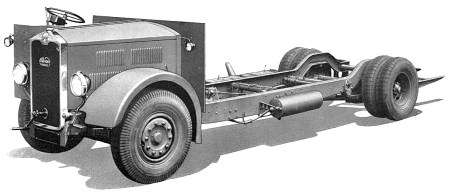|
Welcome to the Albion CX19
Restoration Project Website
This project is run by the Sydney Albion Venturer Group, a group
of Scottish vintage vehicle enthusiasts formed to repatriate and
restore an Albion Venturer CX19 double decker bus, the chassis
of which was built at Scotstoun, Glasgow in 1946. This is the
first project in Scotland supported by the Heritage Lottery Fund
to restore a bus.
|
 |
|
This
illustration of a CX19 chassis is taken from an Albion
leaflet from 1938 |
So whatís so important about our
particular bus? Well, it fills a very important gap in the
ranks of preserved buses in Scotland and the story goes back
over 100 years.
Albion Motors Ltd. of Scotstoun, Glasgow was established in 1899
and quickly became Scotlandís most important commercial vehicle
manufacturer. They made lorries and buses which sold in greater
numbers overseas than they did in their own country.
By the 1940s Albion manufactured an extensive range of lorries
and buses, all with Albion running units and a choice of Albion
petrol or diesel engines. Indeed no other UK manufacturer could
match the range which Albion produced, even though companies
like Leyland and AEC had twice the output.
Realising that such an extensive range could not be sustained,
Albion decided in the late 1940s to withdraw from the double
deck bus market, once current orders had been fulfilled. The
Venturer CX19 had been introduced in 1938 with a choice of
Gardner or Albion diesel engines, but after the war only Albion
engines were offered. Around the time of Albionís decision to
stop production of double deckers, the CX19 had just been
replaced by a newer model, the short lived CX37.
Therefore, with a production life spanning 11 years, interrupted
for 4 years by the Second World War, the Albion CX19 became
Albionís longest lived and most successful double deck chassis
design and more popular overseas than in its home country.
Two cities ran sizeable fleets of these buses Ė Glasgow and
Sydney. By 1961 all of the Glasgow examples had gone, but in
Sydney they remained in service till 1971. And then some went on
to provide even more service with independent operators.
One such bus was m/o 1877, chassis number 60023C, which was one
of 30 Venturer Sp.CX19W chassis ordered by the New South Wales
Department of Government Transport on 21st May 1946 for delivery
before 7th November 1946. In Sydney it was fitted with a 59 seat
steel framed body by Commonwealth Engineering of Granville,
being later converted to 61 seats by the removal of the canvas
front door. It entered service in 1947 and was allocated fleet
number 1877.
It joined the largest fleet of CX19s in the world, which, by
1949, numbered 143, in addition to 17 pre-war examples with
Gardner engines. It was last overhauled in 1966 and was sold in
1970 to a succession of independent operators in New South
Wales, being finally withdrawn in 1981 after an impressive 34
years service. It was then acquired by Australian
preservationist Bruce Pinnell, from whom this Group acquired the
bus in February 2004.
At present there are some 350 preserved buses in Scotland,
representing a wide range of various types which ran in public
service during the last century. Unfortunately no examples of
the Albion CX19 operated in Scotland have survived. However,
with the repatriation of a CX19 from Australia, a very important
gap has now been filled in the ranks of preserved buses. Itís an
example of a fine piece of Scottish engineering from a time when
Scotland was renowned for its engineering excellence throughout
the world and with the help of the Heritage Lottery Fund, the
public will soon be able to ride once again on a type of
Scottish built double decker not operated here since 1961.
|
 website by
website by
easi web |
|

